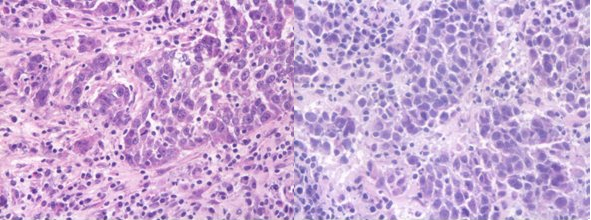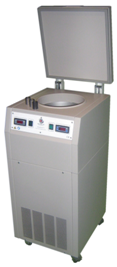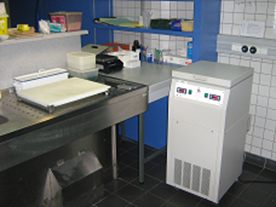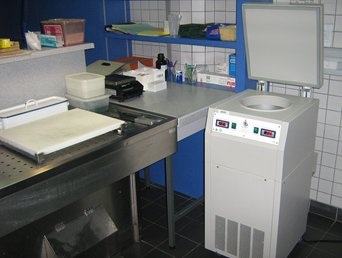 |
|
|
| Reliable and fast frozen diagnosis procedure |
| |
An accurate and fast frozen section histo-diagnosis is critical when deciding for the surgical strategy against the tumour while the patient is still in the surgery theatre. Intraoperative procedures develop rapidly with the objectives to reduce or eliminate the need for recalling the patient for another surgery in a later stage while giving the patient more chances to cure with a more efficient surgery at first attempt.
While frozen section diagnosis has been qualified by numerous studies as “fairly” reliable in approximately 90 % of the studied cases, most of the labs however will recognize that the quality of the staining on frozen sections is frequently not that good if not rather bad, introducing risk of misinterpretation. When the very large part of the frozen sections are obtained by freezing the specimen on the freezing bar of the cryostat, the freezing temperature ranging from -50 max up to -28°C is far from enough to guarantee a reasonable if not excellent quality of staining and thus of diagnosis.
Too high temperature of freezing will allow for the development of big crystals which will damage cell and nucleus walls severely degrading morphology but more importantly staining when stain and counter-stain do mix rendering the discrimination of histology and cells more difficult.
Alternatively, snap freezing tissue specimens in isopentane cooled at -80°C has been widely published for decades to demonstrate the best morphology and molecular quality ever for mainly two reasons: 1) -80°C is recognized as being a low enough temperature to eliminate the risk of large crystals appearance 2) isopentane, contrarily to liquid nitrogen is not degassing when specimen is dipped and thus eliminates the risk of breaks into the specimen that will be occasions for degradations. The SnapFrost® 80 from ALPHELYS provides a very efficient, performing, comfortable and safe solution for snap freezing specimen every day for either frozen section or tissue banking. |
| |
 |
H&E section of human bladder.
Right: frozen on a freezing bar at -40°C in a cryostat (best result that could be obtained), Left: frozen with SnapFrost® at -80°C in isopentane. |
|
| |
| Cancer research and tumour profiling demand high molecular quality and content |
| |
|
Most of the tissue specimens included in tissue banks are liquid nitrogen frozen. Although LN2 provides an ultra low freezing temperature that is beneficial for reducing large crystals appearance in the tissues, it has however a major drawback. LN2 degasses violently when specimen is dipped into it due to the heat brought by the specimen that turns LN2 into gaseous nitrogen. This brutal transition is well known to generate breaks into the specimens that can then be doors for specimen degradations that will happen immediately but also during the long term storage that will follow snap freezing and at time of specimen thawing for its use.
Alternatively, freezing the tissue specimen in isopentane cooled at -80°C provides an efficient and reproducible, well published procedure to guarantee high morphology and molecular qualities.
The tissue specimen snap freezer SnapFrost® from ALPHELYS provides the safest and controlled conditions for repeated -80°C freezing in isopentane at your lab, every day. |
 |
| |
|
| SnapFrost®: The Tissue Specimen Snap Freezer |
| |
 |
 |
| |
SnapFrost® is a very compact instrument which sizes makes it easy to integrate into path lab environment. Based on electrical compressors to cool the isopentane to ultra low temperatures, SnapFrost® is totally independent from liquid nitrogen making this instrument extremely safe to use, eliminating the need for special environment.
Temperature is accurately and permanently controlled guaranteeing perfect quality reproducibility of your frozen specimens. |
|
|
| |
| |
| SnapFrost®: adapted for any format of specimen... |
| |
SnapFrost® is well adapted for any format you need to snap freeze: dip freeze, cryostat specimen holder, cryomold (cryosette), cryotube…the freezing chamber provides a large enough volume to allow for a large variety of formats of specimen to be frozen easily.
For frozen section diagnosis, specimens are frozen within few seconds directly in OCT sitting on the cryostat specimen holder. Once frozen, the specimen is transferred to cryostat and allowed for equilibrating for 1 minute at sectioning temperature. |
| |
|
| …convenient to use and with limited maintenance needs |
| |
SnapFrost® provides a two-level freezing chamber. The lowest level in the centre is regulated at -80° an serves for snap freezing while the upper level is regulated at -40°C and is used to store the frozen specimen during the freezing session and upon waiting for the transfer to deep freezer or cryostat.
The maintenance is limited to cleaning once a year the air inlet filter.
Chamber is easily decontaminated with a paper towel soaked with 70% alcohol. |
| |
| Hospitals, research labs, pharmaceutical research labs or tissue banks have chosen SnapFrost® |
| |
|
| University Hospital Bicêtre, Paris, France, University Hospital Brousse, Paris, France, University Hospital Rennes, France, Inserm, Bordeaux, France, University Hospital Lille, France, University Hospital Sart-Tilman, Liège, Belgium, University Hospital, Zürich, Switzerland, University Hospital Berlin Charite, Germany, Bayer, Germany, University Hospital Oxford, UK, Beijing University, China, Astra Zeneca, Sweden, Carver Iowa University Hospital, USA, ... |
 |
| |
|
| Literature |
| |
| Steu, S., M. Baucamp, G. von Dach, M. Bawohl, S. Dettwiler, M. Storz, H. Moch, and P. Schraml, A procedure for tissue freezing and processing applicable to both intra-operative frozen section diagnosis and tissue banking in surgical pathology. Virchows Arch 2008. |
| |
| Download demonstration |
| |
|
|
ALPHELYS,
Ferme des Ebisoires, Impasse Paul Langevin, 78370 Plaisir - France
Tel +33 (0)1 30 07 52 95 - Fax +33 (0)1 30 07 51 56 - eMail
info@alphelys.com
Copyright © 2001/2011 ALPHELYS, all rights reserved.
|
|
|
|
|
